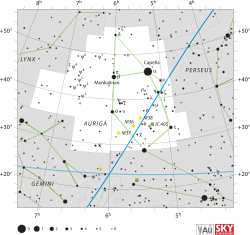Psi5 Aurigae

| |
| Observation data Epoch J2000 Equinox J2000 | |
|---|---|
| Constellation | Auriga |
| Right ascension | 06h 46m 44.3388s[1] |
| Declination | +43° 34′ 38.737″[1] |
| Apparent magnitude (V) | 5.25[2] |
| Characteristics | |
| Spectral type | G0 V[3] |
| U−B color index | +0.06[2] |
| B−V color index | +0.570[4] |
| Astrometry | |
| Radial velocity (Rv) | –24[5] km/s |
| Proper motion (μ) | RA: –1.07[1] mas/yr Dec.: +164.25[1] mas/yr |
| Parallax (π) | 60.56 ± 0.73[1] mas |
| Distance | 53.9 ± 0.6 ly (16.5 ± 0.2 pc) |
| Absolute magnitude (MV) | 4.13[5] |
| Details | |
| Mass | 1.079[6] M☉ |
| Radius | 1.18[6] R☉ |
| Surface gravity (log g) | 4.06[3] cgs |
| Temperature | 5,989[3] K |
| Metallicity [Fe/H] | +0.05[3] dex |
| Rotational velocity (v sin i) | 5.03[4] km/s |
| Age | 3.2[5] Gyr |
| Other designations | |
Psi5 Aurigae (ψ5 Aur, ψ5 Aurigae) is the Bayer designation for a star[8] in the northern constellation of Auriga. It is faintly visible to the naked eye with an apparent visual magnitude of 5.25.[2] Based upon parallax measurements made during the Hipparcos mission, this star is approximately 53.9 light-years (16.5 parsecs) distant from Earth.[1] There is an optical companion[8] which is 36 arcseconds away and has an apparent magnitude of +8.4.
The spectrum of this star shows it to be a G-type main sequence star with a stellar classification of G0 V.[3] Thought to be around 4 billion years old, it is similar in size, mass,[6] and composition to the Sun,[3] making this a solar analog. It is radiating energy into space at an effective temperature of 5,989 K,[3] giving it the golden-hued glow of a G-type star.[9]
Observation in the infrared shows an excess emission that suggests the presence of a circumstellar disk of dust, known as a debris disk. This material has a mean temperature of 60 K, indicating that it is orbiting at a distance of about 29 astronomical units from the host star. The dust has about half the mass of the Moon and is around 600 million years old.[10] The star is being examined for evidence of extrasolar planets,[11] but none have been found so far.
References
- 1 2 3 4 5 6 van Leeuwen, Floor (November 2007), "Validation of the new Hipparcos reduction", Astronomy and Astrophysics, 474 (2): 653–664, arXiv:0708.1752v1
 , Bibcode:2007A&A...474..653V, doi:10.1051/0004-6361:20078357. Note: see VizieR catalogue I/311.
, Bibcode:2007A&A...474..653V, doi:10.1051/0004-6361:20078357. Note: see VizieR catalogue I/311. - 1 2 3 Argue, A. N. (1966), "UBV photometry of 550 F, G and K type stars", Monthly Notices of the Royal Astronomical Society, 133: 475, Bibcode:1966MNRAS.133..475A, doi:10.1093/mnras/133.4.475.
- 1 2 3 4 5 6 7 Cenarro, A. J.; et al. (January 2007), "Medium-resolution Isaac Newton Telescope library of empirical spectra - II. The stellar atmospheric parameters", Monthly Notices of the Royal Astronomical Society, 374 (2): 664–690, arXiv:astro-ph/0611618
 , Bibcode:2007MNRAS.374..664C, doi:10.1111/j.1365-2966.2006.11196.x.
, Bibcode:2007MNRAS.374..664C, doi:10.1111/j.1365-2966.2006.11196.x. - 1 2 Martínez–Arnáiz, R.; et al. (September 2010), "Chromospheric activity and rotation of FGK stars in the solar vicinity. An estimation of the radial velocity jitter", Astronomy and Astrophysics, 520: A79, arXiv:1002.4391
 , Bibcode:2010A&A...520A..79M, doi:10.1051/0004-6361/200913725.
, Bibcode:2010A&A...520A..79M, doi:10.1051/0004-6361/200913725. - 1 2 3 Holmberg, J.; Nordström, B.; Andersen, J. (July 2009), "The Geneva-Copenhagen survey of the solar neighbourhood. III. Improved distances, ages, and kinematics", Astronomy and Astrophysics, 501 (3): 941–947, arXiv:0811.3982
 , Bibcode:2009A&A...501..941H, doi:10.1051/0004-6361/200811191.
, Bibcode:2009A&A...501..941H, doi:10.1051/0004-6361/200811191. - 1 2 3 Takeda, Genya; et al. (February 2007), "Structure and Evolution of Nearby Stars with Planets. II. Physical Properties of ~1000 Cool Stars from the SPOCS Catalog", The Astrophysical Journal Supplement Series, 168 (2): 297–318, arXiv:astro-ph/0607235
 , Bibcode:2007ApJS..168..297T, doi:10.1086/509763.
, Bibcode:2007ApJS..168..297T, doi:10.1086/509763. - ↑ "56 Aur -- Star in double system", SIMBAD Astronomical Database, Centre de Données astronomiques de Strasbourg, retrieved 2012-08-24.
- 1 2 Eggleton, P. P.; Tokovinin, A. A. (September 2008), "A catalogue of multiplicity among bright stellar systems", Monthly Notices of the Royal Astronomical Society, 389 (2): 869–879, arXiv:0806.2878
 , Bibcode:2008MNRAS.389..869E, doi:10.1111/j.1365-2966.2008.13596.x.
, Bibcode:2008MNRAS.389..869E, doi:10.1111/j.1365-2966.2008.13596.x. - ↑ "The Colour of Stars", Australia Telescope, Outreach and Education, Commonwealth Scientific and Industrial Research Organisation, December 21, 2004, retrieved 2012-01-16.
- ↑ Rodriguez, David R.; Zuckerman, B. (February 2012), "Binaries among Debris Disk Stars", The Astrophysical Journal, 745 (2): 147, arXiv:1111.5618
 , Bibcode:2012ApJ...745..147R, doi:10.1088/0004-637X/745/2/147.
, Bibcode:2012ApJ...745..147R, doi:10.1088/0004-637X/745/2/147. - ↑ Grether, Daniel; Lineweaver, Charles H. (April 2006), "How Dry is the Brown Dwarf Desert? Quantifying the Relative Number of Planets, Brown Dwarfs, and Stellar Companions around Nearby Sun-like Stars", The Astrophysical Journal, 640 (2): 1051–1062, arXiv:astro-ph/0412356
 , Bibcode:2006ApJ...640.1051G, doi:10.1086/500161.
, Bibcode:2006ApJ...640.1051G, doi:10.1086/500161.